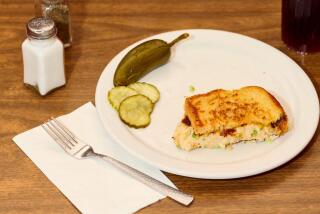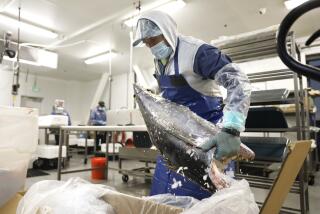Conserving locally caught tuna, Italian style

Improbable as it may have seemed a few years ago, canned tuna is one of the hottest ingredients around today. Good quality stuff, of course, not lunchbox fare. Imported from Spain or Italy, it can sell for as much as $50 a pound. And if it’s ventresca, the richest meat from the belly of the tuna, prices can go even higher.
Paying that kind of money for canned tuna may be surprising, but what’s downright shocking is how amazingly simple it is to make something quite like it at home.
Tuna prepared this way is somewhere between fresh and canned. Let’s called it “conserved,” to honor its inspiration, the old Italian tradition of preserving meat under olive oil, sometimes called conservata.
Especially now, when Southern California’s summer albacore run is heating up and neighborhood fishermen are bringing home their catch, this is something you’ve just got to try.
Here’s how you do it: Cut fresh tuna in big chunks and poach it in olive oil flavored with garlic and spices over very low heat just until the meat begins to flake -- about 15 minutes. Cool in the pan and then store, in the flavored olive oil, in the refrigerator.
The flavor is rich and pure without a trace of fishiness and the texture is downright meaty -- none of that mealiness you sometimes get with commercial stuff. And because you’re controlling the process, you can flavor the oil any way you want, lending subtle hints you won’t find in regular canned tuna.
You can use this conserved tuna in any way you’d use the best canned stuff: make a salad with potatoes and green beans as they do in southern France, or with white beans as they do in Spain. Mix it into a spicy fresh tomato sauce for pasta. Fold it into a caper-y mayonnaise. Stuff it into roasted red peppers. Or just top bruschetta with little chunks of it, being sure to spoon over some of that good olive oil.
About the only thing you can’t do with this tuna is stick it in the pantry and forget about it. Because tuna and other meats are so low in the acidity that would prevent bacterial growth, they must be pressure-canned to be absolutely safe.
On the other hand, conserved tuna will last quite nicely in the refrigerator for a week or more. And this process is so easy you can make it with only a pound or two at a time. Once you taste it, there’s no way that much will last that long.
This quickly conserved tuna has become popular with some chefs and has been included in several recent restaurant cookbooks. I found examples in “The Young Man and the Sea” by David Pasternack of New York’s Esca, the upcoming “A16: Food & Wine” by San Francisco’s Nate Appleman and Shelley Lindgren, and the ever-reliable “The Zuni Cafe Cookbook” by Judy Rodgers.
As I tried out the recipes, the first thing that became apparent was how flexible the technique is. You can cook the tuna briefly or for a long time. You can cook it in water or you can cook it in oil. You can flavor the oil or you can leave it plain.
All of the techniques work, though each results in a slightly different dish. Cooked in water, tuna tastes more purely of fish and the texture is firmer and meatier. Cooked in oil, the flavor is more complex and the texture is softer and richer. Cooked for a long time in oil, the tuna absorbs even more of the garlic and spice flavors, but dries out a bit. Cooked briefly, the flavor isn’t quite as developed, but the texture is nicer.
In the end, I settled on adapting a little bit from several different recipes, cooking the tuna relatively briefly in olive oil flavored with garlic, red pepper, a bay leaf and a big piece of lemon peel.
Along the way, I learned a couple of things. First of all, the quality of the tuna you start with does make a difference but thankfully not as much as you might think. This is important, because fresh tuna can cost the Earth these days.
Though the yellowfin tuna that cost almost $30 a pound at the gourmet grocery was a bit richer in flavor and texture, the $6-a-pound frozen albacore from Trader Joe’s was still very, very good (after thawing overnight in the refrigerator).
The best option, of course, is having a neighbor who’s a fisherman. If you should find yourself in that happy situation, be sure to ask for the fattier belly portion, which they will probably be only too happy to give you (most folks prefer the leaner steaks).
Cut the fish into the biggest chunks you can while maintaining something approaching a cube shape (this will ensure that it cooks evenly). If the tuna’s about an inch thick, that’s how wide you should cut the chunks. Generally, the bigger the chunks, the better, up to about 2 inches.
It’s important to use as small a pan as will hold the tuna and to crowd the chunks of fish together as tightly as possible. Use only enough oil to cover; the flavor seems to be richer this way. I used a 1-quart saucepan to cook 1 poundof tuna, and it took only 1 cup of oil.
Probably the most important thing is controlling the temperature. If the oil gets too hot, the tuna will turn tough. Start the fish in cold oil and cook it over the lowest flame you can manage.
If you see more than an occasional bubble, use a flame-tamer to reduce the heat further.
Turn the heat off as soon as the fish begins to flake. It will continue to cook slowly as the oil cools. The color will change from pink or red to creamy tan, but it will certainly never brown unless the oil is way too hot.
Once the tuna is cool enough to handle, transfer it to a clean, lidded container and pour as much of the flavored cooking oil as will fit over the top. Whatever is left over, spoon onto warm toast, including as much of the sludge of seasonings from the bottom of the pan as you can.
Eat this by yourself and try to keep from laughing. Fishermen are notorious for keeping their secrets, and fish cooks deserve a few of their own.
More to Read
Sign up for our L.A. Times Plants newsletter
At the start of each month, get a roundup of upcoming plant-related activities and events in Southern California, along with links to tips and articles you may have missed.
You may occasionally receive promotional content from the Los Angeles Times.







